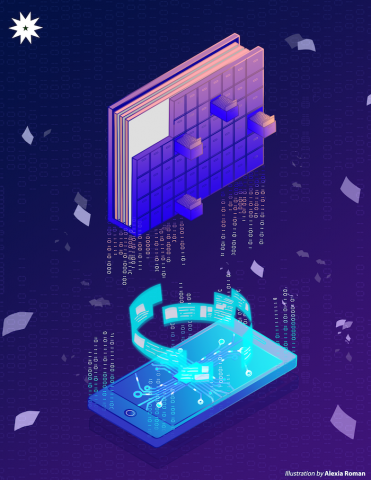
A click of a camera, a scan of a document, and a press of a recording button—by carrying out these seemingly commonplace activities, the public inadvertently participates in preserving memories, an act similar to archiving. This implies that digitizing archives is not a distant concept for the masses, as revealed by Society of Filipino Archivists for Film (SOFIA) Board President Rosemarie Roque. After all, records do not necessarily need to be old or brittle to be archived; as long as they hold a certain sense of value, people will choose to archive them.
Defining digitization
According to the National Archives of the Philippines (NAP) Chief Archivist Ma. Teresa Pagaragan and the Philippine Veterans Affairs Office (PVAO), digitization can be simply considered as the conversion of original archives from analog formats to digital ones. Similarly, Roque shares that digitization is a type of reformatting, which entails the “migration of content from one form to another.”
However, it must be made clear that archive digitization should not be confused with an entirely different concept of digitalization. The latter refers to the usage of digital technologies to change existing processes and create new models; on the other hand, digitization refers to the transfer of information from physical documents to digital form.
It also wholly differs from digital preservation—while digitization simply transfers information from one medium to another, digital preservation ensures that the stored information remains accessible and authentic through time. Hence, digitization and digital preservation are both intertwined processes.
Preserving the original
Each archiving organization has its own set of processes for digitizing archives. Yet, all methods remain anchored on a singular principle: to preserve the original.
Pagaragan highlights that the NAP’s technical working group carefully inspects all digitized outputs to ensure that no information has been tampered with. According to her, they ensure that all documents are a faithful reproduction of the original copy before finally uploading it to the server.
“We see to it [that our] technical working group [follows the] procedure [in] scanning [and in] digitization,” Pagaragan posits.
Meanwhile, Roque shares the importance of exercising due diligence when digitizing and how it ensures authenticity and non-repudiation. “Ganoon ka-importante [ang due diligence], para kaya mo ipagtanggol din yung material. Definitely, may magkwekwestiyon nang magkwekwestiyon sa material, pero kaya mong sagutin,” she explains.
(Due diligence is important so that you can protect the material. There will always be someone who would question the material, but you would be able to answer them.)
Even then, preserving the original is not as easy as scanning an archival document. Archivists must first decide which collections to prioritize based on factors such as the materials’ age and condition, as well as the means and level of access to the archived documents. They would also have to identify their digitization process, with options to pursue in-house digitizing or outsource aid from external digitization experts.
Afterward, the NAP proceeds to manually paginate each document to account for each specific tidbit of information. The PVAO, meanwhile, engages in archive scanning and enhancement. They adjust the size, position, and readability of the document before transferring it to another hard drive for backup. Similarly, the Human Rights Violations Victims’ Memorial Commission (HRVVMC) also saves their digitized files in a hard drive.
But, the digitization process does not end after storing a backup copy of the file elsewhere. Archivists are still expected to continue carefully preserving both the original and digital documents.
“Kung sabihin natin lumubog si Manila (server), nandoon ang aming mga backup copies, mayroon kaming office sa Davao and Cebu,” Pagaragan says.
(For example, if the Manila server suddenly shuts down, we have backup copies in the Davao and Cebu offices.)
This step is also crucial for agencies such as HRVVMC, which archives and digitizes the records of human rights victims during the Martial Law period. Executive Director Chuck Crisanto reveals that they send copies of their archives to multiple educational institutions across the Philippines and in foreign countries to ensure [their] safekeeping. “ [Even] if this primary collection is destroyed by fire or raided, the book remains—I just have to launch the password, and it can be opened,” he shares.
Needed updates
With digitizing being a tedious process, Roque shares that archivists face multiple challenges. For instance, the lack of proper equipment and funding hinders the digitization of certain documents. The PVAO, which focuses on materials related to World War II, struggles with digitizing large maps from the period. With the presence of such challenges, the HRVVMC hopes to secure a 3D scanner to digitize the physical artifacts donated by Martial Law victims.
“Kailangan makahanap pa sila ng equipment kung paano siya maii-scan kasi ‘pag dinaan sa scanning, posibleng maapektuhan yung brittle na records,” Pagaragan shares.
Security, privacy, and storage concerns also play a role as the documents are kept in a digital storage, such as network-attached storage and hard drives. The fast-changing nature of technology also tends to make older devices obsolete, posing another challenge regarding the shelf life of digitized documents.
Beyond that, the PVAO laments the difficulty in creating a digitizing team with sufficient experience and expertise for the myriad of tasks in the process; after all, personnel training is quite resource-intensive. That, paired with the Philippines’ lack of adequate academic institutions granting a formal degree in archiving, unfortunately, means that a professional digitizing team is hard to come by.
With this reality, it is clear that the digitization of the Philippines’ archives still has a long way to go. Nevertheless, recent updates in the archival field, such as the mentioned UP SLIS introduction of a Master’s degree program in archives and records management, pave the way for a brighter future ahead for digitizing. Its progress, after all, plays a crucial role in preserving national knowledge and expanding its accessibility. As Crisanto says, “Our history will be preserved, and that’s the most important thing.”
